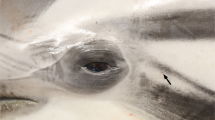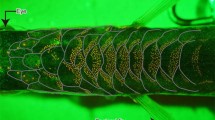Summary
The gross anatomy and nerve supply of the bill of echidna (Tachyglossus aculeatus) is described in relation to its function as an outstanding sensory organ. The sensory innervation of the skin of the echidna snout was investigated by means of frontal serial sections, after decalcification of the specimens. A comprehensive light and electron microscopic description of the location and fine structure of cutaneous sensory receptors of the trigeminal system was made by this means. The encapsulated and non-encapsulated Ruffini receptors, the types of other free receptors in the connective tissue and the Merkel cell receptor do not differ morphologically from those of higher mammals, whereas the pacinian-like corpuscle shows a unique organization of its outer core. This is composed of large perineural cells containing a unique reticulum of parallel-orientated endoplasmic membranes. Lamellated corpuscles, seen in isolation or in association with push rods, are numerous in the snout and in the tip of the tongue of echidna. Push rod receptor organs occur in the hairless skin of the bill with a very dense array at its rostral end and in the pseudopalatal ridges. Gland duct receptors are restricted to the skin adjacent to the nostrils and the mouth opening, including the pseudopalatal plates. Only about one quarter of the total number of 400 seromucous glands receive a sensory innervation of their intraepidermal duct segment. Within each innervated gland two types of receptor terminals are identified.
The distributions of the different receptor types are mapped for different regions of the skin, the mucous membrane of the nasal and oral vestibule and the tip of the tongue. The fine structure of nerve terminals is discussed from a comparative anatomical point of view, and some speculations are made about possible transduction processes that underlie the known electrophysiological properties. The sensory organs such as the “push rod” and “gland duct receptor”, and most of their sensory terminals, are less differentiated in echidna snout than in the platypus (Ornithorhynchus anatinus) bill.
Similar content being viewed by others
References
Andres KH (1973) Morphological criteria for the differentiation of mechanoreceptors in vertebrates. In: Schwartzkopf J (ed) Symposium Mechanoreception. Abhdlg Rhein Westf Akad Wiss. Westdeutscher Verlag Bd 53:135–152
Andres KH, Düring v M (1973) Morphology of cutaneous receptors. In: Iggo A (ed) Handbook of sensory physiology (vol II) Springer, Berlin Heidelberg New York, pp 3–28
Andres KH, Düring v M (1974) Interferenzphänomene am osmierten Präparat für die systematische elektronenmikroskopische Untersuchung. Mikroskopie 3:139–149
Andres KH, Düring v M (1977) Interference phenomenon on osmium tetroxide-fixed specimens for systematic electron microscopy. In: Hayat A (ed) Principles and techniques of electron microscopy. Van Nostrand Reinhold, New York, Biol Appl 8:246–261
Andres KH, Düring v M (1981) General methods for characterization of brain regions. In: Heym Ch, Forssmann WG (eds) Techniques in neuroanatomical research. Springer, Berlin Heidelberg New York, pp 100–108
Andres KH, Düring v M (1984) The platypus bill. A structural and functional model of a pattern-like arrangement of different cutaneous sensory receptors. In: Hamann W, Iggo A (eds) Sensory receptor mechanisms. World Scientific, Singapore, pp 81–89
Andres KH, Düring v M (1985a) Rezeptoren und nervöse Versorgung des bronchopulmonalen Systems. Bochumer Treff 31
Andres KH, v Düring M (1985b) Die Fadenfeder als Rezeptororgan. Verh Anat Ges 79:501
Andres KH, Düring v M (1988) Comparative anatomy of vertebrate electroreceptors. In: Hamann W, Iggo A (eds) Transduction and cellular mechanisms in sensory receptors. Prog Brain Res 74; Elsevier, Amsterdam, pp 113–131
Andres KH, Düring v M (1989) Ein Verfahren der Auflicht-Makrophotographie zur Darstellung zentralnervöser Nervenverbindungen in Hirnpräparaten. Photomed 2:269–274
Andres KH, Düring v M (1990) Comparative and functional aspects of the histological organization of cutaneous receptors in vertebrates. In: Zenker W, Neuhuber WL (eds) The primary afferent neuron. Plenum Press, New York, pp 1–17
Andres KH, v Düring M, Schmidt RF (1985) Sensory innervation of the Achilles tendon by group III an IV afferent fibers. Anat Embryol 172:145–156
Andres KH, Düring v M, Muszynski K, Schmidt RE (1987) Nerve fibers and their terminals of the dura mater encephali of the rat. Anat Embryol 175:289–301
Bohringer RC (1981) Cutaneous receptors in the bill of the platypus (Ornithorhynchus anatinus). Austr Main 4:93–95
Chambers MR, Andres KH, Düring v M, Iggo A (1972) The structure and function of the slowly adapting Type II mechanoreceptor in hairy skin. Q J Exp Physiol 57:417–445
Doran GA, Baggett H (1972) cit. Griffiths M (1978) The biology of the monotremes. Academic Press, New York
Düring v M (1974) The radiant heat receptor and other tissue receptors in the scales of the upper jaw of Boa constrictor. Z Anat Entwicklungsgesch 145:299–319
Düring v M, Miller MR (1978) Sensory nerve endings of the skin and deeper structures. In: Gans C (ed) Biology of the reptilia (vol 9) Neurology A Academic Press, London New York, pp 407–441
Friedrich VL, Mugnaini E (1981) Preparation of neural tissue for electron microscopy. In: Heimer L, Robards MJ (eds) Neuroanatomical tract-tracing methods. Plenum Press, New York London, pp 345–374
Gregory JE, Iggo A, McIntyre AK, Proske U (1987) Electroreceptors in the platypus. Nature 326:387–387
Gregory JE, Iggo A, McIntyre AK, Proske U (1988) Receptors in the bill of the platypus. J Physiol 400:349–366
Gregory JE, Iggo A, McIntyre AK, Proske U (1989) Responses of electroreceptors in the snout of the echidna. J Physiol 414:521–538
Griffiths M (1978) The biology of the monotremes. Academic Press, New York
Halata Z (1971) Innervation der unbehaarten Nasenhaut des Maulwurfs (Talpa europaea). II. Innervation der Dermis (einfache eingekapselte Körperchen). Z Zellforsch Mikrosk Anat 125:108–120
Halata Z, Rettig T, Schulze W (1985) The ultrastructure of sensory nerve endings in the human knee joint capsule. Anat Embryol 172:265–275
Halata Z, Strasmann T (1990) The ultrastructure of mechanoreceptors in the musculo-skeletal system of mammals. In: Zenker W, Neuhuber WL (eds) The primary afferent neuron. Plenum Press, New York, pp 51–65
Iggo A, McIntyre AK, Proske U (1985) Responses of mechanoreceptors and thermoreceptors in the skin of the snout of echidna. Proc R Soc Lond [Biol] 223:261–277
Iggo A, Proske U, McIntyre AK, Gregory JE (1988) Cutaneous electroreceptors in the platypus: a new mammalian receptor. In: Hamann W, Iggo A (eds) Transduction and cellular mechanisms in sensory receptors. Prog Brain Res 74. Elsevier, Amsterdam, pp 133–138
Karnowsky MJ (1965) A formaldehyde-glutaraldehyde fixative of high osmolarity for use in electron microscopy. J Cell Biol 27:137A
Knibestöl M (1973) Stimulus-response functions of rapidly adapting mechanoreceptors in the human glabrous skin area. J Physiol 232:427–452
Kolmer W (1925) Zur Organologie und mikroskopischen Anatomic vonZaglossus bruijni. Z Wiss Zool 125:448–482
Kürten L, Schmidt U (1982) Thermoreception in the common vampire bat (Desmodus rotundus). J Comp Physiol 146:223
Kürten L, Schmidt U, Schäfer K (1984) Warm and cold receptors in the nose of the vampire bat,Desmodus rotundus. Naturwissenschaften 71:327
Kuhn HJ (1971) Die Entwicklung und Morphologie des Schädel von Tachyglossus aculeatus. Abh Senckenb Naturforsch Ges 528:1–224
Loewenstein WR (1971) Mechano-electric transduction in the pacinian corpuscle. Initiation of sensory impulses in mechanoreceptors. In: Loewenstein WR (ed) Handbook of sensory physiology (vol 1) Principles of receptor physiology. Springer, Berlin Heidelberg New York, pp 269–290
Poulton EB (1885) On the tactile terminal organs and other structures in the bill ofOrnithorhynchus. J Physiol (Lond) 5:15–16
Poulton EB (1894) The structure of the bill and hairs ofOrnithorhynchus paradoxus with a discussion of the homologies and origin of mammalian hair. Q J Micr Sci 36:143–199
Proske U, Gregory JE, Iggo A, McIntyre AK (1988) An electrical sense in echidnas. Proc Aust Physiol Pharmacol Soc 19:190
Reynolds ES (1963) The use of lead citrate of high pH as an electron-opac stain in electron microscopy. J Cell Biol 17:208–212
Scheich H, Langner G, Tidemann C, Coles RB, Guppy A (1986) Electroreception and electrolocation in platypus. Nature 319:401–402
Smith AP, Wellham GS, Green SW (1989) Seasonal foreaging activity and microhabitat selection by echidnas (Tachyglossus aculeatus) on New England Tablelands. Aust J Ecol 14:457–466
Staubesand J, Andres KH (1953) Graphische Rekonstruktion zur räumlichen Darstellung präterminaler Gefäße und intravasaler Besonderheiten. Mikroskopie 84:111–120
Tachibana T, Fujiwara N, Nawa T (1990) The ultrastructure of the ganglionated nerve plexus in the nasal vestibular mucosa of the musk shrew (Suncus murinus, Insectivora) Arch Histol Cytol 53:147–156
Wilson JT, Martin CJ (1893) On the peculiar rod-like tactile organs in the integument and mucous membrane of the muzzle ofOrnithorhynchus. Linn Soc NSW, Maclay Mem 1893, pp 190–200
Author information
Authors and Affiliations
Rights and permissions
About this article
Cite this article
Andres, K.H., von Düring, M., Iggo, A. et al. The anatomy and fine structure of the echidnaTachyglossus aculeatus snout with respect to its different trigeminal sensory receptors including the electroreceptors. Anat Embryol 184, 371–393 (1991). https://doi.org/10.1007/BF00957899
Accepted:
Issue Date:
DOI: https://doi.org/10.1007/BF00957899




